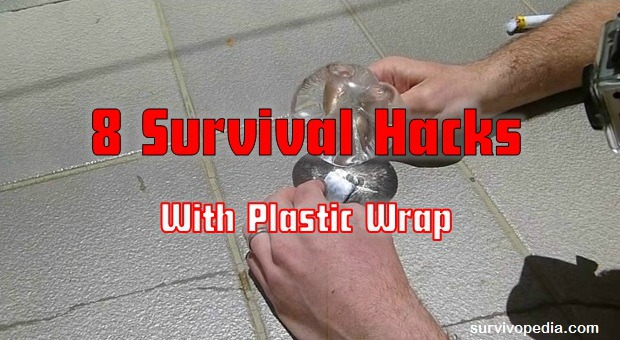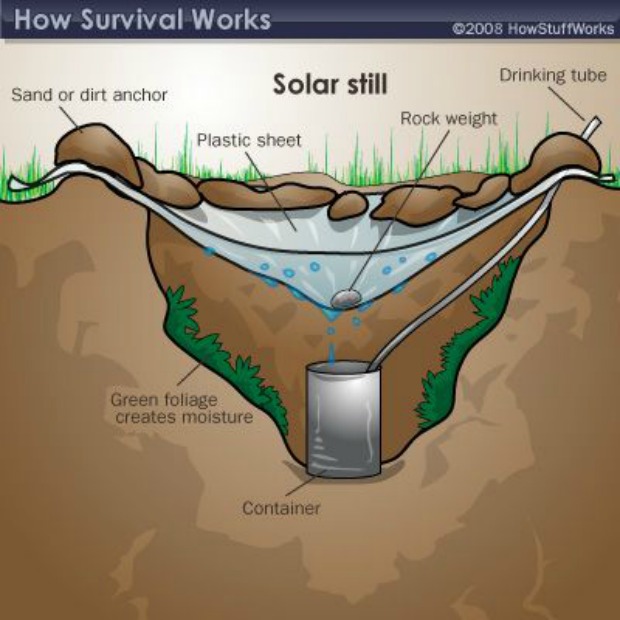You’ve probably battled with your fair share of plastic wrap while trying to cover a bowl of leftovers, but that stickiness is one of its biggest assets when it comes to using it for survival.
That’s right – you can use plastic wrap for many different things if SHTF, so keep several rolls of it in your stockpile!
When I say plastic wrap, you can use the kitchen plastic wrap in a pinch, but you can also buy an entire roll of clear or green translucent plastic wrap at the hardware store that they use to wrap pallets. This type is much more durable than the plastic wrap meant for use in the kitchen. It’s dirt cheap, too.
1. Staying Warm and Dry
Possibly the best thing about plastic wrap is that it’s pretty much impermeable. That means that air and water can’t pass through it, so if you’re stuck in a storm or have to venture out in the cold, plastic wrap can be one of your best friends.
Not only does it keep air and moisture out, it keeps body heat in, so if you wrap your torso, limbs, and feet in it, you can preserve a ton of body heat and stay dry at the same time, which will also help you stay warm.
The only thing to remember when you’re using it this way is that your skin needs to breathe. That means that as soon as you get someplace warm and dry, you need to take it off.
2. Collecting Rain Water
There are a couple of different ways that you can use plastic wrap to collect water. The first way is the obvious way –hang a sheet of it so that it’s horizontal to the ground and let it collect either rainwater or dew.
If you have a bucket or container, even better – set the bucket underneath the plastic and use a stone to tilt it to one side, so that the water pours off of the plastic into the bucket.
If you just set the bucket out when it rains, you’ll only catch the water that directly drops into the bucket, but the plastic wrap will give you a larger area for the rain to hit, thus collecting much more water.
3. Create a Solar Still
The second way that you can use plastic to collect water is to build a solar still. This sounds a lot fancier than it actually is.
Dig a hole in soil that is in direct sunlight – this is important because you’re using the sun to dehydrate the moisture from the damp soil.
As the soil dehydrates, the water evaporates and rises, creating condensation on the plastic. Here’s how to do it:
- Dig a hole in direct sunlight, preferably early in the morning. Make the hole a foot or two deep – the more damp soil you have exposed, the more water you’ll get.
- Place a mug, bowl, or some other vessel to collect the water in the center of the hole.
- Fill around the cup with any damp vegetation that you can find. The more moisture, the better.
- Cover the hole completely with plastic wrap.
- Place sand, dirt, and rocks around the outside perimeter of the hole to seal the plastic wrap to the ground.
- Place a small stone or some dirt on the plastic directly over the center of the cup so that it forms a V into the cup. The plastic can’t touch the cup, though.
- Leave the still there as long as possible – either until the dirt dries up or the sun goes down, whichever comes first.
- If the hole dries up, either dig it deeper to reach more damp soil, or dig another hole and start over.
- Enjoy the water. You won’t collect much this way, but in a survival situation, some is better than none!
You can also use plastic wrap to make a solar still to distill dirty water or salt water into drinking water. For a better visual for this purpose, check out this video.
Video first seen on desertsun02.
4. Build a Shelter or a Greenhouse
Yup, you read that right. You can build a shelter using plastic wrap. As a matter of fact, we just built one to use as a make-shift paint booth. We used the skeleton from a picnic tarp for the frame, but trees would do just as well.
Simply wrap the plastic wrap around the trees, or poles that you cut, then cover the top of it, too. We used a piece of cardboard to fashion a door, but you could just as easily cut a small, 3-sided entrance in the hole then wrap a stick around the vertical side and stick it in the ground to “close” the door.
Seal it up from the inside with another piece of plastic. You’re creative – I’m sure you can figure out an entrance.
It also collected dew on the top, so your plastic wrap house serves double duty as a water collector. This will make a wind-proof, waterproof shelter that is actually fairly durable and will hold heat inside.
This trait would also make it excellent material for building a greenhouse.
5. Start a Fire
You can use plastic wrap to start a fire. I didn’t really believe this was possible until I found a video that proved it. The idea is that water in a piece of plastic wrap acts as a magnifying glass.
Video first seen on The Outdoor Adventure.
The paper actually caught fire fairly quickly – within a couple of minutes, so it’s not something that I would discount.
Actually, starting the fire with the plastic and water seemed easier than using a bow, so if those were my only two options, I’d probably try the plastic wrap and water first. We have other great ideas for staring fires.
6. Waterproofing Your Gear
There’s nothing worse than trekking through a downpour and stopping for the night only to find that everything in your pack is soaked, too.
Maybe you’ve dropped it in a stream that you were crossing, or had to swim at some point. In any of these scenarios, plastic wrap would have kept your gear dry.
It’s not a total waterproofer, but I have used it when I’m out on a long distance ride – I don’t have saddlebags – to keep my pack dry. I just have a piece folded up in the bottom of my bag and when I need it, I unfold it and wrap my bag in it.
It probably wouldn’t do a lot of good if my bag was submerged, but it would give me a few extra seconds to catch it if I dropped it in the lake. You could also use it to cover things such as your firewood in camp to protect it from a downpour.
7. Rope or Lashing Material
Yes, rope is always good to have on hand. There’s no doubt about it. Plastic wrap used for shrink wrap is extremely strong and if you twist a piece into a rope (you have to twist it), it will stretch to about three times its original length then hold there. We tested it and it held 115 pounds without threatening to give.
That’s pretty solid for some plastic, especially when you consider that you can untwist it and use it for other things.
8. First Aid
There are several ways you can use plastic wrap for first aid.
First, a sucking chest would needs to be covered with plastic. You could also use it as a non-stick covering to keep water and debris out of a wound. It would work as a sling, or you could wrap it around as a binding. Throw some in your first aid kit.
In a survival situation think of what you can do with what you have. This is what our ancestors used to do.
Click the banner below and discover their most valuable survival secrets!
This article has been written by Chris Black for Survivopedia.
2 total views, 2 views today
from Survivopedia
Don't forget to visit the store and pick up some gear at The COR Outfitters. How prepared are you for emergencies?
#SurvivalFirestarter #SurvivalBugOutBackpack #PrepperSurvivalPack #SHTFGear #SHTFBag




No comments:
Post a Comment